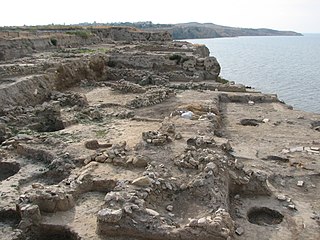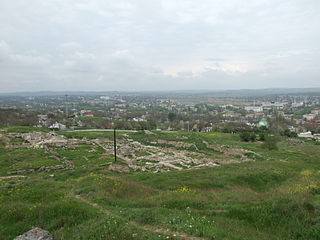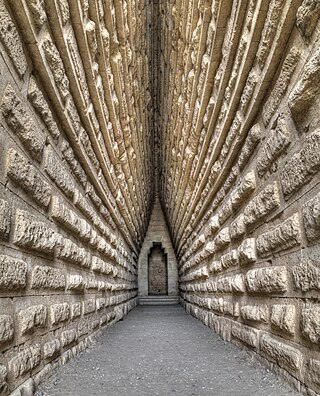
Kerch, also known as Keriç or Kerich, is a city of regional significance on the Kerch Peninsula in the east of Crimea. It has a population of 147,033 .

The Bosporan Kingdom, also known as the Kingdom of the Cimmerian Bosporus, was an ancient Greco-Scythian state located in eastern Crimea and the Taman Peninsula on the shores of the Cimmerian Bosporus, centered in the present-day Strait of Kerch. It was the first truly 'Hellenistic' state, in the sense that a mixed population adopted the Greek language and civilization, under aristocratic consolidated leadership. Under the Spartocid dynasty, the aristocracy of the kingdom adopted a double nature of presenting themselves as archons to Greek subjects and as kings to barbarians, which some historians consider unique in ancient history. The Bosporan Kingdom became the longest surviving Roman client kingdom. The 1st and 2nd centuries AD saw a period of a new golden age of the Bosporan state. It was briefly incorporated as part of the Roman province of Moesia Inferior from AD 63 to 68 under Emperor Nero, before being restored as a Roman client kingdom. At the end of the 2nd century AD, King Sauromates II inflicted a critical defeat on the Scythians and included all the territories of the Crimean Peninsula in the structure of his state.

Kazimierz Józef Marian Michałowski was a Polish archaeologist and Egyptologist, art historian, member of the Polish Academy of Sciences, professor ordinarius of the University of Warsaw as well as the founder of the Polish Centre of Mediterranean Archaeology. He coined the term "Nubiology" to refer to the study of ancient Nubia.

Pontic Olbia or simply Olbia is an archaeological site of an ancient Greek city on the shore of the Southern Bug estuary in Ukraine, near the village of Parutyne. The archaeological site is protected as the National Historic and Archaeological Preserve. The preserve is a research and science institute of the National Academy of Sciences of Ukraine. In 1938–1993 it was part of the NASU Institute of Archaeology as a department.

Berenice Troglodytica, also called Berenike or Baranis, is an ancient seaport of Egypt on the western shore of the Red Sea. It is situated about 825 km south of Suez, 260 km east of Aswan in Upper Egypt and 140 km south of Marsa Alam. It was founded in 275 BCE by Ptolemy II Philadelphus (285–246 BCE), who named it after his mother, Berenice I of Egypt.

Tmutarakan was a medieval principality of Kievan Rus' and trading town that controlled the Cimmerian Bosporus, the passage from the Black Sea to the Sea of Azov, between the late 10th and 11th centuries. Its site was the ancient Greek colony of Hermonassa founded in the mid 6th century BCE, by Mytilene (Lesbos), situated on the Taman peninsula, in present-day Krasnodar Krai, Russia, roughly opposite Kerch. The Khazar fortress of Tamantarkhan was built on the site in the 7th century, and became known as Tmutarakan when it came under the control of Kievan Rus'.

Phanagoria was the largest ancient Greek city on the Taman peninsula, spread over two plateaus along the eastern shore of the Cimmerian Bosporus.

Faras was a major city in Lower Nubia. The site of the city, on the border between modern Egypt and Sudan at Wadi Halfa Salient, was flooded by Lake Nasser in the 1960s and is now permanently underwater. Before this flooding, extensive archaeological work was conducted by a Polish archaeological team led by professor Kazimierz Michałowski.

Greek Crimea concerns the ancient Greek settlements on the Crimean Peninsula. Greek city-states first established colonies along the Black Sea coast of Crimea in the 7th or 6th century BC. Several colonies were established in the vicinity of the Kerch Strait, then known as the Cimmerian Bosporus. The density of colonies around the Cimmerian Bosporus was unusual for Greek colonization and reflected the importance of the area. The majority of these colonies were established by Ionians from the city of Miletus in Asia Minor. By the mid-1st century BC the Bosporan Kingdom became a client state of the late Roman Republic, ushering in the era of Roman Crimea during the Roman Empire.

Marina, also Marina El Alamein , ancient Leukaspis or Antiphrae, is an upscale resort town catering mainly to the Egyptian upper class. It is located on the northern coast of Egypt, with an 11 km (6.8 mi) long beach, about 300 km (190 mi) away from Cairo, in the El Alamein area.

The Warsaw National Museum, also known as the National Museum in Warsaw, is a national museum in Warsaw, one of the largest museums in Poland and the largest in the capital. It comprises a rich collection of ancient art, counting about 11,000 pieces, an extensive gallery of Polish painting since the 16th century and a collection of foreign painting including some paintings from Adolf Hitler's private collection, ceded to the museum by the American authorities in post-war Germany. The museum is also home to numismatic collections, a gallery of applied arts and a department of oriental art, with the largest collection of Chinese art in Poland, comprising some 5,000 objects.

Myrmēkion or Myrmecium was an ancient Greek colony in the Crimea. The settlement was founded in the eastern part of the modern city Kerch, 4 km NE of ancient Panticapaeum on the bank of the Kerch bay near the cape Karantinny. The settlement was founded by Milesians in the first half of the 6th c. BC.

Kimmerikón was an ancient Greek city in Crimea, on the southern shore of the Kerch Peninsula, at the western slope of Opuk mountain, roughly 40 kilometres southwest of modern Kerch. It was situated with its acropolis on the hills on the west side of the mountain. The town was founded by the Milesian colonists in the 5th century BC and flourished at the beginning of the Christian era. Its name may refer to an earlier Cimmerian settlement on the site.

Nýmphaion, also known as Nymphaion on the Pontus, was a significant centre of the Bosporan Kingdom, situated on the Crimean shore of the Cimmerian Bosporus. Today it is located near the resort town Heroivske. It lies at a distance of about 14 kilometers south of Kerch, which was the site of ancient Panticapaeum.

Metsamor site is the remains of an old fortress located to the southwest of the Armenian village of Taronik, in the Armavir Province.
The Crimean Peninsula was under partial control of the Roman Empire during the period of 47 BC to c. 340 AD. The territory under Roman control mostly coincided with the Bosporan Kingdom . Rome lost its influence in Taurica in the mid third century AD, when substantial parts of the peninsula fell to the Goths, but at least nominally the kingdom survived until the 340s AD. The Eastern Roman Empire, the eastern part of the Roman Empire that survived the loss of the western part of the empire, later regained Crimea under Justinian I. The Byzantine Empire controlled portions of the peninsula well into the Late Middle Ages.

Paphos Archaeological Park contains the major part of the important ancient Greek and Roman city and is located in Paphos, southwest Cyprus. The park, still under excavation, is within the Nea Pafos section of the coastal city.

Mariupolitan Greek, or Crimean Greek also known as Tauro-Romaic or Ruméika, is a Greek dialect spoken by the ethnic Greeks living along the northern coast of the Sea of Azov, in southeastern Ukraine; the community itself is referred to as Azov Greeks. Although Ruméika, along with the Urum language, remained the main language spoken by the Azov Greeks well into the 20th century, currently it is used by only a small part of Ukraine's ethnic Greeks.

The Royal Kurgan or Tsarskyi Kurgan from the 4th century BC, is one of the most impressive tumuli (kurgans) of the eastern Crimea. The burial barrow is located in the present-day Kerch (Ukraine), which developed out of the ancient Greek town of Panticapaion (Παντικάπαιον) founded by Miletus.

The Research Centre in Cairo, Polish Centre of Mediterranean Archaeology University of Warsaw, is the only Polish scientific research institution in Africa and the Middle East, where it has operated since 1959 in Cairo. The mission of the Research Centre is to develop and expand Polish research in the region, particularly in the Nile Valley. It is operated by the Polish Centre of Mediterranean Archaeology, an independent research institute of the University of Warsaw. The PCMA Cairo Research Centre is located in two buildings situated in close proximity to one another in the Cairo Heliopolis district — in antiquity the centre of a religious cult and the location of the Egypt's reputedly largest temple.



















